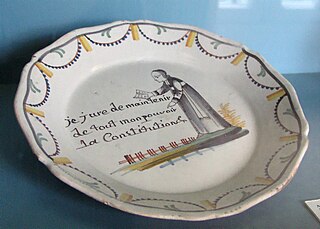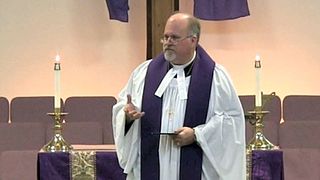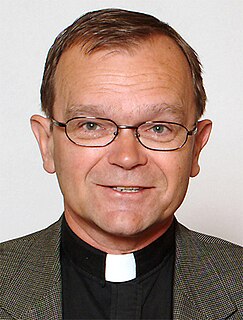The Very Reverend William Smith was Provost of Aberdeen in the middle of the 18th century. [1]
The Very Reverend William Smith was Provost of Aberdeen in the middle of the 18th century. [1]
| Anglican Communion titles | ||
|---|---|---|
| Preceded by | Provost of St Andrew's Cathedral, Aberdeen 1735– 1774 | Succeeded by John Skinner |

The Church of England is a Christian church and also the established church of England. The archbishop of Canterbury is the most senior cleric, although the monarch is the supreme governor. The Church of England is also the mother church of the international Anglican Communion. It traces its history to the Christian church recorded as existing in the Roman province of Britain by the 3rd-century, and to the 6th-century Gregorian mission to Kent led by Augustine of Canterbury.

A cathedral is a church that contains the cathedra of a bishop, thus serving as the central church of a diocese, conference, or episcopate. Churches with the function of "cathedral" are usually specific to those Christian denominations with an episcopal hierarchy, such as the Catholic, Anglican, Eastern Orthodox, and some Lutheran churches. Church buildings embodying the functions of a cathedral first appeared in Italy, Gaul, Spain, and North Africa in the 4th century, but cathedrals did not become universal within the Western Catholic Church until the 12th century, by which time they had developed architectural forms, institutional structures, and legal identities distinct from parish churches, monastic churches, and episcopal residences.

Clergy are formal leaders within established religions. Their roles and functions vary in different religious traditions, but usually involve presiding over specific rituals and teaching their religion's doctrines and practices. Some of the terms used for individual clergy are clergyman, clergywoman, and churchman. Less common terms are cleric, churchwoman, and clergyperson, while clerk in holy orders has a long history but is rarely used.

The Reverend is an honorific style most often placed before the names of Christian clergy and ministers. There are sometimes differences in the way the style is used in different countries and church traditions. The Reverend is correctly called a style but is often and in some dictionaries called a title, form of address or title of respect. The style is also sometimes used by leaders in non-Christian religions, such as Judaism.

A curate is a person who is invested with the care or cure (cura) of souls of a parish. In this sense, "curate" correctly means a parish priest; but in English-speaking countries the term curate is commonly used to describe clergy who are assistants to the parish priest. The duties or office of a curate are called a curacy.

The Civil Constitution of the Clergy was a law passed on 12 July 1790 during the French Revolution, that caused the immediate subordination of the Catholic Church in France to the French government.

A clergy house is the residence, or former residence, of one or more priests or ministers of religion. Such residences are known by various names, including parsonage, manse, and rectory.

In Christianity, a minister is a person authorised by a church or other religious organization to perform functions such as teaching of beliefs; leading services such as weddings, baptisms or funerals; or otherwise providing spiritual guidance to the community. The term is taken from Latin minister, which itself was derived from minus ("less").
Clerical clothing is non-liturgical clothing worn exclusively by clergy. It is distinct from vestments in that it is not reserved specifically for services. Practices vary: is sometimes worn under vestments, and sometimes as the everyday clothing or street wear of a priest, minister, or other clergy member. In some cases, it can be similar or identical to the habit of a monk or nun.

The Congregation for the Clergy is the congregation of the Roman Curia responsible for overseeing matters regarding priests and deacons not belonging to religious orders. The Congregation for the Clergy handles requests for dispensation from active priestly ministry, as well as the legislation governing presbyteral councils and other organisations of priests around the world. The Congregation does not deal with clerical sexual abuse cases, as those are handled exclusively by the Congregation for the Doctrine of the Faith.

A clerical collar, clergy collar, Roman collar or, informally, dog collar is an item of Christian clerical clothing. The collar closes at the back of the neck, presenting a seamless front. The shirt may have the collar built in. The clerical collar is almost always white and was originally made of cotton or linen but is now frequently made of plastic. Sometimes it is attached with a collaret or collarino that covers the white collar almost completely, except for a small white square at the base of the throat, and sometimes with the top edge of the collar exposed to mimic the collar of a cassock. It may simply be a detachable tab of white in the front of the clerical shirt. The clerical shirt is traditionally black, but today is available in a variety of colors depending on the wearer's preference. Once the clerical collar is removed the garment is indistinguishable from any other shirt. When clergy are delivering sermons, they sometimes attach preaching bands to their clerical collar.
Independent Catholicism is a denominational movement of clergy and laity who self-identify as Catholic and form "micro-churches claiming apostolic succession and valid sacraments", in spite of not being affiliated to the historic Catholic churches such as the Roman Catholic and Old Catholic churches. The term "Independent Catholic" derives from the fact that "these denominations affirm both their belonging to the Catholic tradition as well as their independence from Rome."
The term secular clergy refers to deacons and priests who are not monastics or members of a religious institute. A diocesan priest is a Catholic, Anglican or Eastern Orthodox priest who commits themself to a certain geographical area and is ordained into the service of the citizens of a diocese, a church administrative region. That includes serving the everyday needs of the people in parishes, but their activities are not limited to that of their parish.
The Right Reverend is a style applied to certain religious figures.
A chartophylax, sometimes also referred to as a chartoularios, was an ecclesiastical officer in charge of official documents and records in the Greek Orthodox Church in Byzantine times.
Clerical celibacy is the discipline within the Catholic Church by which only unmarried men are ordained to the episcopate, to the priesthood in some autonomous particular Churches, and similarly to the diaconate. In other autonomous particular churches, the discipline applies only to the episcopate.
Crockford's Clerical Directory (Crockford) is the authoritative directory of Anglican clergy and churches in the United Kingdom and Ireland, containing details of English, Irish, Scottish and Irish benefices and churches, and biographies of around 26,000 clergy in those countries as well as the Church of England Diocese in Europe in other countries. It was first issued in 1858 by John Crockford, a London printer and publisher.
The greca, or more properly the douillette, is a clerical double-breasted overcoat worn over the cassock. The greca is slightly longer than the cassock so as to entirely cover it.
The Clergy of the Church of England database (CCEd) is an online database of clergy of the Church of England between 1540 and 1835.